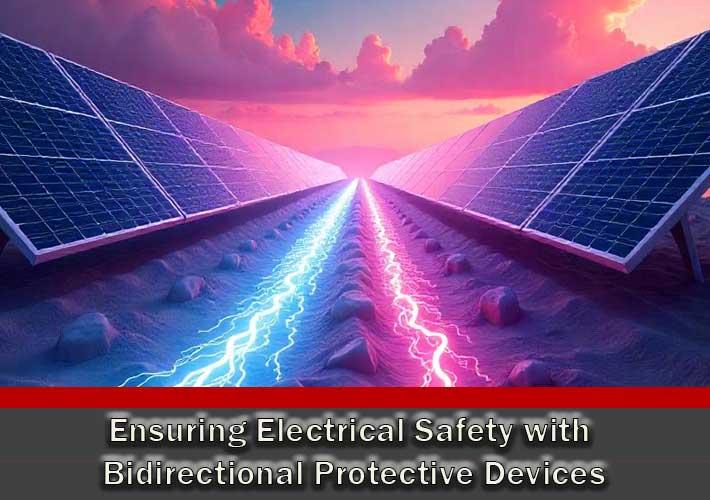Protecting electrical systems has grown increasingly complex with the rise of installations that allow power to flow in more than one direction. This shift is especially relevant in systems incorporating multiple power sources, such as solar panels, battery storage, and EV chargers. Recent guidance from BEAMA’s 2024 technical bulletin raised serious safety concerns over traditional protective devices failing under bidirectional current conditions. To ensure safety and regulatory compliance, devices must now operate reliably regardless of the current’s direction—marking a pivotal change in the approach to circuit protection.
A Vital Change in Wiring Regulations
Amendment 3 to BS 7671:2018, coming into effect in July 2024, introduces new standards to address bidirectional current in modern installations. A key addition, Regulation 530.3.201, requires designers and installers to consider current flow direction when selecting protective devices.
Two types of devices are now officially defined:
-
Bidirectional devices – Accept power supply connections at either or both terminal sets
-
Unidirectional devices – Allow power supply only at one specific terminal set
This change reflects the increasing complexity of today's electrical systems, especially in setups involving renewable generation, energy storage, or EV infrastructure.
Labelling and Device Selection
Proper identification and installation are crucial.
-
Unidirectional devices are clearly labelled ‘In/Supply’ and ‘Out/Load’. They are suitable only where current flows in a single direction and must be installed according to manufacturer instructions.
-
Bidirectional devices, on the other hand, use neutral markings like ‘L/N’ or ‘L1/N1’ and ‘L2/N2’, with no defined input or output terminals. They are essential for systems with multiple power sources.
Incorrectly using unidirectional devices in bidirectional systems can result in failure and compromise safety.
Power Flow in Solar PV Systems
-
Single-direction flow: In basic solar PV systems without batteries, energy flows from the panels, through the inverter, to the consumer unit. Despite this, Regulation 530.3.201 still requires the use of bidirectional devices, due to differing supply and load connection points.
-
Multi-directional flow: When battery storage is added, current may flow:
-
From the PV system to the grid or battery
-
From the grid to the battery
-
From the battery to the installation
-
This complexity makes bidirectional protection essential for compliance with Regulation 826.1.2.2, which mandates safety measures for all current flow directions in “prosumer” setups.
Further Safety Requirements
Protective devices in bidirectional systems must:
-
Function reliably regardless of current direction
-
Include neutral disconnection if providing RCD protection
This ensures full isolation and increased safety, especially in renewable installations with varying power sources.
Updated Inspection Standards
As inspection criteria evolve, assessors must now verify the correct use of bidirectional or unidirectional devices. Classification codes should be applied as follows:
-
Code 1 – Immediate danger (rare)
-
Code 2 – Urgent action required (e.g. improper device type used)
-
Code 3 – Improvement recommended
Industry guidance advises defaulting to bidirectional devices for future-proofing and ease of compliance.
Unidirectional vs. Bidirectional Devices
-
Unidirectional:
-
Designed for one-way flow
-
Clearly marked terminals
-
Often use electronic circuits for protection
-
Must be connected exactly as specified
-
-
Bidirectional:
-
Support two-way flow
-
No need to identify line/load sides
-
Ideal for solar, EVs, and battery systems
-
Provide greater installation flexibility
-
Why Bidirectional Protection Is Crucial
Modern systems often combine power generation and consumption.
-
Solar installations require protection whether feeding the grid or drawing from it.
-
Battery systems charge and discharge, demanding dual-flow protection.
-
EV charging increasingly involves vehicle-to-grid functionality.
Without appropriate devices, safety and system reliability are at risk.
Where You’ll Find Bidirectional Devices
-
Solar systems – Maintain safety in both generation and grid-feed modes
-
Battery storage – Seamless protection during charging and discharging
-
EV charging – Manage power flow in both directions
-
Microgrids – Handle multiple power sources and flow directions
-
Hybrid systems – Enable flexible integration of renewables
Which Circuit Breakers Are Bidirectional?
Some RCDs and MCBs are inherently bidirectional, but manufacturers are now releasing updated models to comply with new standards. Products currently available include:
-
FuseBox mini RCBOs
-
FuseBox RCDs and MCBs
-
Elucian Bi-Directional Switched Neutral True RCBOs
Conclusion
As the UK transitions to smarter, greener energy systems, understanding the difference between bidirectional and unidirectional protection is essential. Bidirectional devices offer the adaptability, safety, and performance needed for systems where energy can flow in either direction—such as solar panels, batteries, and EVs.
By staying informed and selecting the right protective equipment, installers and specifiers can ensure safety, future-proof their systems, and remain compliant with evolving regulations.



